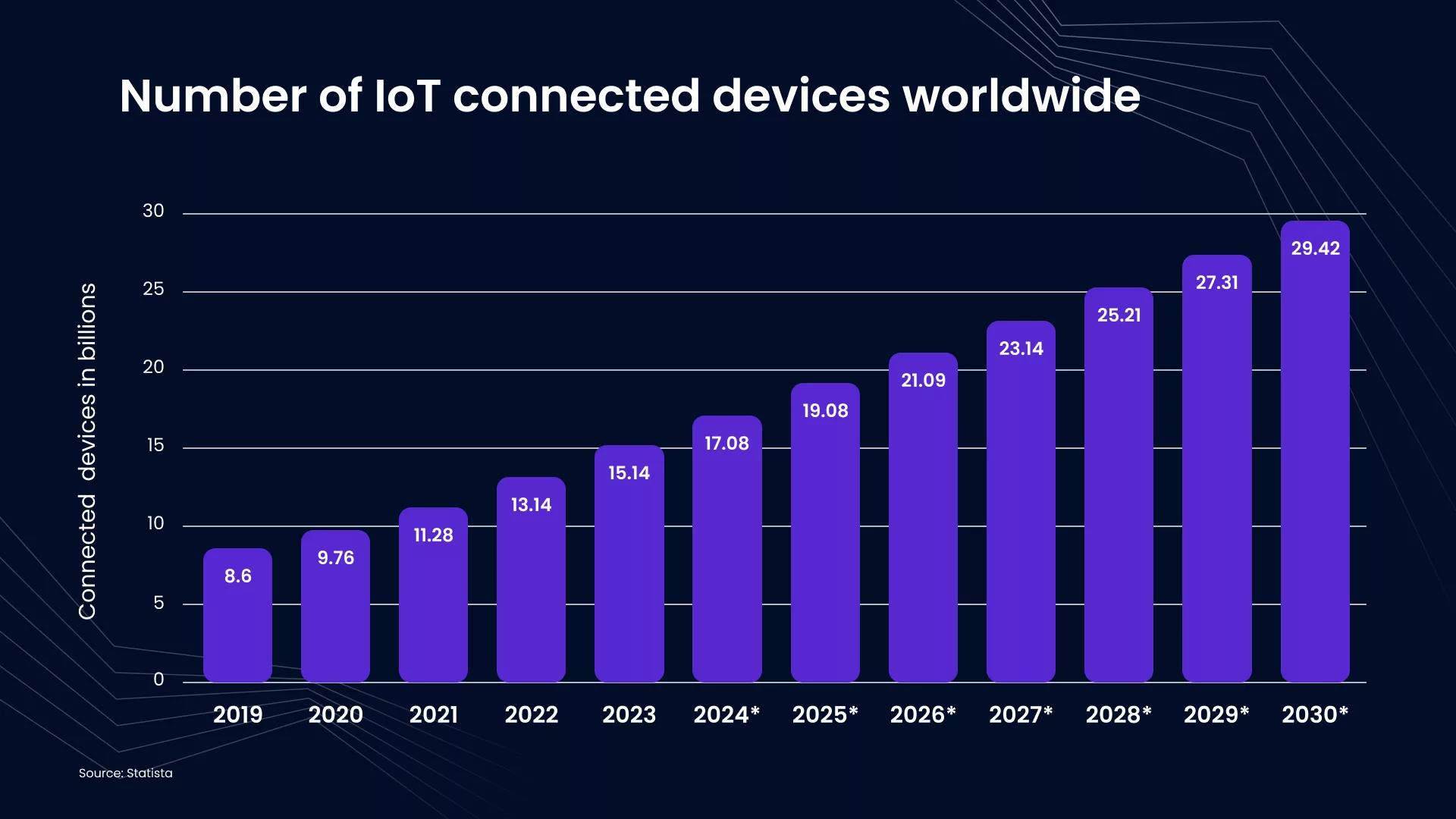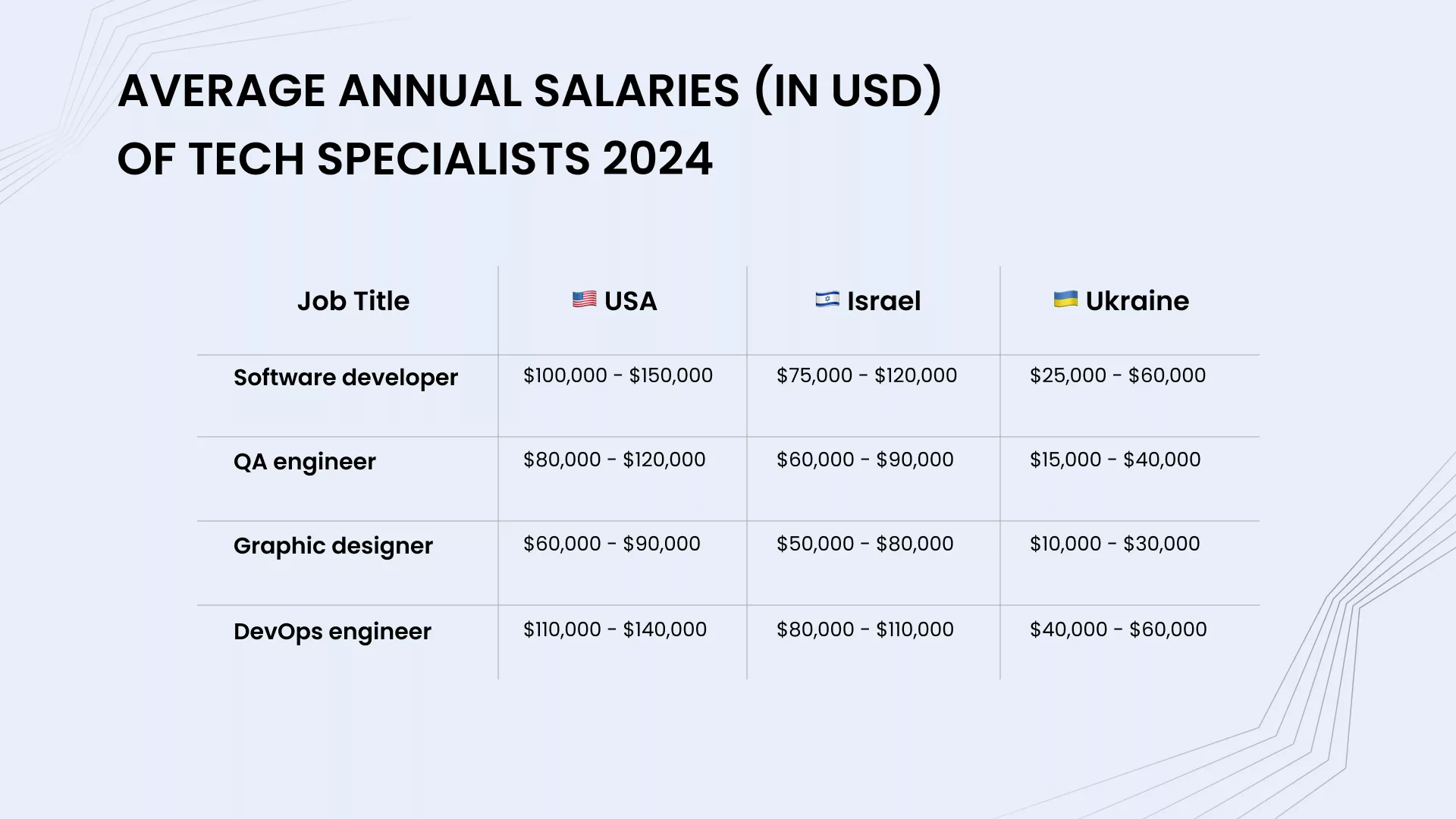
The once-static realm of IT outsourcing is undergoing a metamorphosis. In 2024, businesses are no longer simply offloading tasks; they’re strategically partnering with external experts to unlock a new level of efficiency and innovation. This shift is driven by the ever-growing complexity of technology and the emergence of powerful new tools like artificial intelligence.
Content:
- What’s going on in the tech talent labor market in 2024?
- Top outsourced IT services in 2024
- Shifts in IT outsourcing (2019 vs. 2024)
- Outsourcing IT recruitment – staff augmentation and offshore hiring
- Outsourcing pricing trends 2024
- Summing up
By harnessing a combination of human expertise and machine intelligence, companies can tackle IT challenges with greater agility and unlock a competitive edge in the digital age.
What’s going on in the tech talent labor market?
The booming tech job market has hit a pause button. The number of job postings has significantly decreased, particularly in areas like software development (down 45% according to Indeed Job Postings Index) and information design and documentation (down 39%). This shift likely reflects a reevaluation by companies in response to a changing economic landscape, including slower growth, evolving consumer needs, and rising interest rates.

While there have been layoffs in the tech industry in recent years, the overall picture of a global IT talent shortage in 2024 might be a bit nuanced.
Skill mismatch. Layoffs might not necessarily address the specific skill sets companies are looking for. The demand might be for specialists in areas like cloud, cybersecurity, or AI/ML, while layoffs might impact other areas.
Geographical imbalance. The talent shortage might be more prominent in certain regions or for specific skill sets. Even with layoffs, there could be a lack of qualified professionals in some areas.
Upskilling and reskilling. Laid-off tech workers could potentially bridge the gap if they’re able to upskill or reskill themselves in high-demand areas.
Therefore, it’s more accurate to say that the IT talent landscape in 2024 might be in a state of flux, with pockets of shortage and surplus depending on location and skill sets.
Top outsourced IT services in 2024, according to MWDN
The IT outsourcing market, which includes software development, infrastructure management, cloud services, and technical support, is projected to reach $512.5 billion in revenue this year. This makes outsourcing one of the most influential and widespread business practices globally.
Companies increasingly outsource various IT services to gain a competitive edge. Here’s a closer look at some top outsourced IT services and why they rise.
Cloud computing
Cloud computing involves storing and accessing data and applications over the internet instead of on local servers. Moving IT infrastructure and applications to cloud platforms like AWS, Azure, or GCP remains a priority. Companies need expertise in cloud migration strategies, security, and ongoing management. As a part of IT services, cloud computing worth is going to hit $1,266.4 billion by 2028
Why outsource it? Cloud providers offer expertise in managing and securing cloud infrastructure, allowing companies to focus on core business activities. Additionally, cloud services are scalable, so companies can pay only for the resources they use.
Cybersecurity
Cybersecurity refers to the practice of protecting systems, networks, and data from unauthorized access, use, disclosure, disruption, modification, or destruction. With growing threats, cybersecurity services are in high demand. This includes penetration testing, vulnerability management, and SOC management.
Why outsource it? Cybersecurity threats are constantly evolving, requiring specialized skills and knowledge. Outsourcing allows companies to access a wider pool of cybersecurity expertise without the cost of hiring full-time security professionals.
AI and ML
AI is the intelligence exhibited by machines, while ML is a type of AI that allows computers to learn without being explicitly programmed. Expertise in AI and ML development is booming. Companies seek outsourced teams to build AI applications, automate tasks, and gain data insights. According to Gartner, spendings on AI will reach almost 300 billion US dollars in three years.
Why outsource it? Developing and implementing AI/ML solutions requires specialized skills and significant computing power. Outsourcing allows companies to leverage expertise and infrastructure they might not have in-house.
Application development and maintenance
Classic application development remains important, but there’s a growing focus on niche areas like mobile app development, DevOps practices, and low-code/no-code development.
Why outsource it? Outsourcing allows companies to access a wider pool of developers with specific skill sets needed for their projects. It can also be a cost-effective way to address short-term project needs or ongoing maintenance tasks.
Big data and analytics
Big data refers to large and complex datasets that are difficult to process with traditional methods. Big data analytics involves extracting insights from this data to inform business decisions. Organizations increasingly turn to outsourced teams for data analysis, data warehousing, and building data-driven solutions.
Why outsource it? Analyzing large datasets requires specialized tools and expertise. Outsourcing allows companies to access skilled data analysts and data scientists without the high cost of hiring them in-house.
Blockchain
Blockchain is a distributed ledger technology that allows for secure, transparent recording of transactions. It offers transformative potential for secure transactions, supply chain management, and more.
Why outsource it? Due to its complexity, many companies prefer to outsource blockchain development and integration to specialized vendors, leveraging their expertise for secure, efficient implementations.
IoT
The IoT refers to the network of physical devices embedded with sensors, software, and other technologies that collect and exchange data. IoT solutions are increasingly used to improve operational efficiency, customer experience, and product innovation.

Why outsource it? Managing and analyzing data from IoT devices can be complex. Outsourcing allows companies to access expertise in managing IoT deployments and deriving insights from the data collected, and navigate the complexities of IoT technology, including sensor integration, data collection, and analytics.
IT services that are still widely outsourced in 2024
Software development. Custom software development is highly sought after for businesses looking to differentiate their offerings. Outsourcing allows access to a global talent pool, fostering innovation, reducing time-to-market, and managing costs. The global IT outsourcing market, with a strong focus on software development, was valued at over $300 billion, demonstrating the sector’s vitality.
Managed IT services. This encompasses a wide range of IT tasks, including network management, IT support, and infrastructure management. Outsourcing these services allows companies to enjoy predictable IT costs, reduce downtime, and improve operational efficiency. The managed services market has been growing steadily, indicating the value businesses find in outsourcing day-to-day IT management.
IT support. External IT support can provide 24/7 assistance, ensuring that businesses can address technical issues quickly and maintain continuity. Outsourcing IT support is cost-effective and allows companies to scale support needs based on demand.
On the rise: Outsourcing SDRs. Companies are increasingly outsourcing their Sales Development Representative function. SDRs are responsible for prospecting, qualifying leads, and scheduling meetings with potential customers.
The Bridge Group, a research and consulting company focused on sales effectiveness, reported an average in-house SDR tenure of just 1.5 years in their 2023 report. This high turnover rate highlights the challenge of retaining SDR talent, and outsourcing can provide more stability in your sales development function.
Shifts in IT outsourcing (2019 vs. 2024)
Specialization. There’s a growing demand for specialized outsourcing partners with expertise in specific technologies or industries (e.g., healthcare IT, fintech).
Nearshore outsourcing. While offshore outsourcing is still popular, nearshore outsourcing (outsourcing to geographically closer countries) is gaining traction due to time zone overlap and cultural similarities.
Security concerns. Data security and privacy are top concerns. Companies are more selective in choosing outsourcing partners with strong security practices and compliance certifications.
Automation and AI. The rise of automation and AI is impacting IT outsourcing. Simple, repetitive tasks are increasingly automated, while AI is used for tasks requiring strong analytical skills. This may shift the focus towards more complex projects requiring human expertise.
Outsourcing IT recruitment – staff augmentation and offshore hiring
Outsourcing IT recruitment, staff augmentation, and offshore hiring are expected to be a major trend in 2024. Why so?
- Geopolitical considerations. Rising tensions in more and more regions might make companies hesitant to rely solely on nearshore or offshore resources, while diversification across locations can mitigate risk.
- Hybrid models. The rise of hybrid work models means companies need talent with the flexibility to work remotely or in an office. Staff augmentation allows them to access skilled professionals who can adapt to these models.
- Collaboration tools. The success of remote work has shown the effectiveness of collaboration tools. Companies can leverage staff augmentation with a focus on these tools to ensure seamless teamwork despite geographical distance.
- Flexible contractual arrangements. The need for agility is driving a demand for flexible contractual arrangements in IT recruitment. Staff augmentation allows companies to scale their teams up or down quickly based on project needs.
Overall, outsourcing IT recruitment offers companies a way to access a wider talent pool, fill specific skill gaps, and adapt to the evolving work landscape.
MWDN has worked in IT consulting, outsourcing, and staff augmentation for over 20 years. Here are some of our notorious cases:
For an AI-based marketing platform, we were to find a unique Data scientist with AI/ML expertise and operate a team distributed among the Czech Republic, Ukraine, and Hungary. We came out to the international labor market to find the best specialist. We also provided operational support to help our client manage an efficient and always-available dedicated team of four people.
For a digital media vendor, we were to find and hire a media team. Something we never did before. We hired four experts, including a Media Buyer, an Affiliate Marketing, and a User Acquisition Manager.
For a recruitment and HRM automatization company, we were to assemble two large teams in two big Ukrainian cities. We built a team of back-end and front-end departments, QA, and Database engineers, distributed across Kyiv and Kharkiv, two large Ukrainian cities.
For a cybersecurity company, we were to assemble a team while applying reference checks, cultural fit assessments, and background checks. In MWDN, we call highly skilled, motivated, and in all respects, unique tech experts the Rock Stars. Finding a whole band of talented and dedicated employees who can perform at the highest level took us considerable effort, but we did it!
Check out our portfolio to find out more about our expertise.
Outsourcing pricing trends 2024
Pricing plays a major role in the continued rise of IT outsourcing and staff augmentation in 2024. Here’s how companies are optimizing costs.
Flexible pricing models. Traditional fixed-cost models are giving way to more flexible options. Hourly rates, project-based pricing, and performance-based incentives allow companies to pay for the specific skills and deliverables they need.
Competitive pricing. The global talent pool allows companies to compare rates and find skilled professionals at competitive prices. This can lead to significant cost savings compared to building an in-house team.

Optimizing costs goes beyond just price. For example, outsourcing eliminates the need for companies to invest in infrastructure, software, and employee benefits for additional IT staff. Moreover, by outsourcing IT functions, companies can free up internal resources to focus on core business activities, potentially leading to increased revenue.
Summing up
The most outsourced IT services in 2024 are those that have emerged just recently, like cloud computing, big data analysis, and AI/ML. Other, more traditional services, like software development or IT-managed services, maintain their quite high volume.
Along with these trends, staff augmentation or outsourcing IT recruitment gains more popularity as companies see the benefits of this approach (more agility, more control over the team, lower direct labor costs). Looking for a cost-effective software development team to reinforce your in-house department? Contact MWDN and let us help find, hire, and manage your perfect remote IT specialist.


